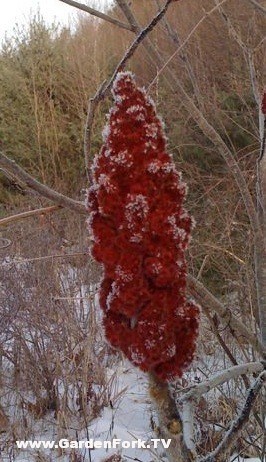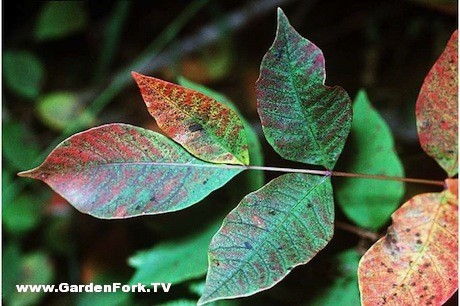Part of our Foraging and Urban Homesteading Video Series, we show you how to forage for foods in your backyard. This foraging video is about the Staghorn Sumac and the tea or sumac-ade you can make from the seedhead of a sumac tree.

Staghorn Sumac
I remembered this drink you can make from a report I did in 6th grade, it was a cookbook of sorts of Native American foods, I think my teacher was underwhelmed by report I did, but this must have had an influence on me, in some subtle way.
In addition to the tea you can make from foraged sumac, the sumac seed pods are used in middle eastern cooking. The seeds are ground and used as a spice powder, added to dishes such as hummus and salads. neat!
According to Wikipedia, the center stem of the sumac was also used by native americans as pipe stems. Sumac also had medicinal uses in Medieval times.
Sumacs grow along forest and field edges, fence rows and the sides of the road. They are called a pioneer plant, they are one of the first bush plants to grow where a field is turning into a forest, or where the soil has been disturbed.
Their leaves are an easy way to identify the plant, especially in the fall, as they have a great red-yellow color to them.
Be sure to know the difference between Staghorn Sumac and Poison Sumac. The names of the plants are similar, but the plants do look quite a bit different. Staghorn sumac has a very unique upright seed head, usually red in color. Poison Sumac looks much more like poison ivy, and its seeds hang downward.

Poison Sumac looks like Poison Ivy - USDA photo
What can you add to our knowledge of Staghorn Sumac and foraging? Let us know below:

David Pastor de la Orden
Great video! Thanks for the foraging series, love it... Even if I don't have sumacs around, I've checked the wiki entry for it and there are some points you'll like...
I've followed with acorns and I've already prepared couscous, croquettes, cakes, soup... funny stuff, in fact. And as yesterday it was Halloween I've grabbed five pumpkins/squashes and I'm just wondering what to do with them (ideas and videos will be very welcomed)...
I met some wild amaranthus plants round the corner the other day and I've also taken the seeds... around a kilo... still thinking about its use.
Well, I'll be longing for the next entry. Thanks for your time and great job!
David.
Tonia Moxley
I think this is the same sumac used in middle eastern dishes. Good to know it can be harvested in the Appalachian mountains, too!
Tonia Moxley
Duh, if I had read the text, I would have seen you already know it's used in the Middle East!
htc titan ii unlock
Nice answer back in return of this matter with solid arguments and explaining everything
about that.
cars
Buying a used car can be tricky, no matter how much you already
know about cars. There are lots of different things to consider
so that you don't end up buying a piece of junk that breaks down right away. Use some great tips of the trade in the following article to help you make your next car choice.
Wolf
Ah-ha! I figured out why your expression was not thrilled when you drank your tea, Eric. It sounds like all the advice you received was the opposite of what makes for a really good sumac-ade.
Use cold water only and you won't release any tannins, but the refreshing ascorbic acid is easy to dissolve.
Don't rinse the berries off! And wait a few days after any rain, so the rain won't wash away the flavor. What I think happened for you is that you rinsed them and your delicous drink went down your kitchen sink.
Wash your hands well and then strip the berries off in cold water. Filter the water through a coffee-filter or cheesecloth, or in my case a clean rag cut from a worn T-shirt. Refrigerate. Try it out. Better than lemonade! I don't even sweeten it.
Eric Gunnar Rochow
thanks for the info! that is good to know next time i try this. thx, eric.
Andrew
I understand the berries ripen in late summer. Can they be harvested through fall and into winter?